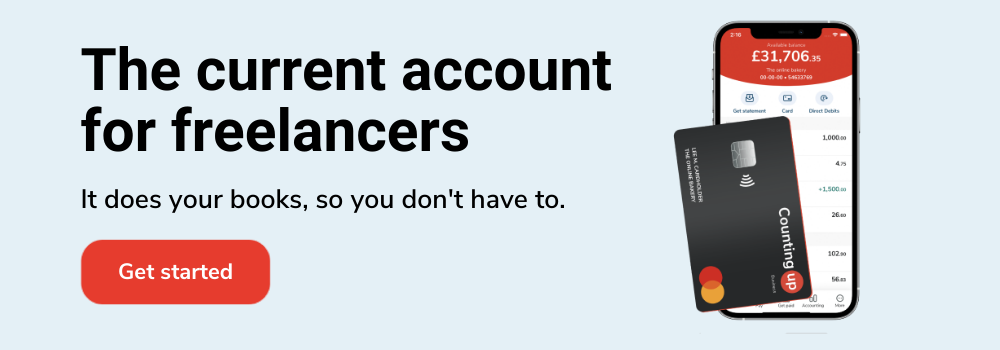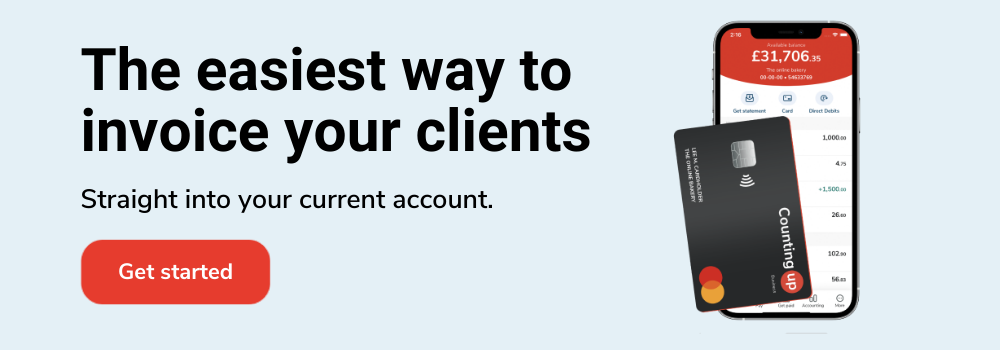How to start as a freelance graphic designer
Table of Contents
Have you always had a creative side and like the idea of being free to choose your own hours? Whether you’re an established graphic designer or just starting out, a freelancing career could be the perfect fit for you. You’ll get the opportunity to work with lots of different clients and choose what and how much you work on at one time.
In this guide, you’ll learn:
- What a graphic designer does
- What you need to become a graphic designer
- How to start freelance graphic design work
- How to find clients for your freelance design business
- How to invoice clients for your designs
What a graphic designer does
Graphic designers use digital tools to develop visual ideas and concepts. You could work on anything from advertising campaigns or branding for large organisations to product packaging, magazines and brochures.
As a freelance graphic designer, you’ll be your own boss, choosing what clients you work with and how much you charge.
What you need to become a graphic designer
Graphic designers need to have IT and drawing skills combined with a creative flair. They also need to be problem solvers with excellent communication skills to find and explain their solutions to clients.
Most professional graphic designers also have a degree in graphic design or other art and design-related subjects.
However, the most important qualification you’ll need is a working knowledge of desktop design software like Illustrator, or InDesign. You’ll also need knowledge of image editing software like Photoshop. You can learn these skills through online courses or by taking a college course.
The more qualifications you have, the more likely you are to get clients from the get-go.
How to start freelance graphic design work
Below we’ve listed the key steps you need to take to start freelance graphic design work.
Step 1: Choose a specialism
Graphic design is a heavily competitive profession. Specialising in a specific niche can help you stand out from the crowd and bring in the right clients. Any differentiation you can offer can help you attract work and deepen your expertise in your area.
Here are some niches you could focus on:
- Visual identity – branding elements like logos, colour palettes, imagery, and fonts
- Packaging – creating the designs for companies’ product packaging
- Content marketing – designing various content marketing elements like digital guides and brochures, social media banners, email marketing templates, or brand books.
When choosing your specialism, try making it simple for yourself. Instead of picking the most complicated designs thinking that’s what you need to succeed, focus on something you enjoy and can do well.
Step 2: Set up your business
Many freelance graphic designers work alone as sole traders. However, you can also choose to set up a limited company too.
Unsure on which to choose? Check out how to set up as a sole trader or limited company.
Whatever you decide, it’s always a good idea to open a business current account to keep your business and personal finances separate. Countingup is the perfect solution for freelance graphic designers, as it helps you keep track of your expenses and you can even invoice from the app.

Step 3: Protect yourself with insurance
It’s always a good idea to protect yourself if something goes wrong when you’re working. Here are three insurance covers that most freelancers would be wise to get:
- Professional indemnity insurance – protects you if you make an error in your work and lose a client, which makes it one of the most important insurance policies for freelancers.
- Public liability insurance – protects you if a member of the public gets ill, injured or suffers a loss and tries to blame your business.
How to find clients for your freelance design business
Once you’re done setting up your freelance business, it’s time to start finding clients. We’ve listed some tips to help you get your business off the ground faster and start making money as a graphic designer.
Create a professional portfolio
As a graphic designer, your portfolio is key to winning new business. After all, how will clients know what you can do if they can’t see it?
If you’ve worked on a bunch of different projects before, you can cherry-pick the best pieces that show what you’re truly capable of. Bonus points if the designs relate to your specialism!
In addition to your designs, it’s also a good idea to include some basic information about your process, including:
- What the brief was
- What your role in the project was
- What you did and why
If you’re new to graphic design and haven’t worked on any projects yet, try creating some designs for pretend projects and explain how you did it. The idea is to demonstrate your skills in any way you can.
Next up: how to craft a killer graphic design portfolio
Set up a website
As a freelancer, you’ll need to brand and market yourself as companies do. The most effective way is to create and maintain a professional website where you showcase your work. You can use systems like WordPress, Wix, or Squarespace to create your website for free or at a reasonable price.
Share your designs and information about the projects and add them to your website. You’ll also want to create a page where you share some information about yourself (focusing on your skills and experience).
Remember that your website acts as a portfolio in itself, so make sure you use every inch to demonstrate your skills, from the colour scheme and moving images to your About page.
Leverage your social media channels
Social media is great for finding graphic design clients, especially LinkedIn and Instagram. You can use these platforms to look for jobs, join groups, connect with potential clients, and share your designs to promote your skills.
Optimise your profiles using keywords that recruiters and companies will likely use to find freelancers in your field and niche. For example, ‘graphic designer’, ‘freelance creative’, or ‘designs & animations’.
You can also use your platform to contribute to discussions and connect with other graphic designers to find inspiration.
Use your network
Graphic design may be an art, but so is networking. When you enter the world of freelancing, you need to tell everyone what you’re doing.
Reach out to your existing network of friends, family, old schoolmates and ask if they have or know of any opportunities. If you’ve spent time in the business world already, you might also have a network of professional connections who could give you recommendations.
Networking is an excellent way to spread the word about your new business and an opportunity to work on your sales and communication skills. After all the practice you get pitching your ideas to people you know, you’ll be much better prepared when you need to pitch to clients.
Networkkk
Get social proof
Once you’ve completed a few successful projects for clients, you could ask them if they’d be willing to provide a testimonial or review. While the idea of asking for good feedback might feel uncomfortable, it’s worth doing. Online reviews are very effective, and research shows that 88% of people trust them.
If clients can see positive feedback from businesses you’ve worked with before on your website and social media, it’ll reassure them that you actually have the skills and knowledge you claim.
How to invoice your clients
As you start working with clients, you get to the stage of invoicing them for your work. But how do you charge clients for your designs? Follow the steps below to make sure you get it right:
Step 1: Establish the work and payment
Start by determining your brief, timeline, and requirements. Then make sure the client can pay by your preferred method, or how else they can pay if not.
Bank transfers and online card payments are the most common payment methods, but freelancers sometimes also accept payments via PayPal, Klarna or Venmo. Whatever way you use, always establish payment terms before beginning a project.
Step 2: Making the invoice
UK Government guidelines state that invoices across all industries must include the following key accounting and business information as standard:
- Key dates about the work: deadline, expected payment, and the invoice’s creation.
- Information about your business: your business name, address, contact details, website, and other vital information under the heading ‘supplier’.
- Information about the client: name, address, contact details etc., under the heading ‘client’.
- Itemised cost breakdown and description: services, tools and materials you’re invoicing your clients for.
- A payment reference: assign your invoices a unique identification number that shows clients which invoice they’re paying (you can use a simple number or labelling system).
- Payment information: specify which payment method you require, account details like a bank account or PayPay address, and the total amount due.
- A friendly note: not necessary, but it can be a nice way to build good business relationships. You can write something like “Thank you for working with me!”
Read our full guide on how to invoice a client for freelance work
The easiest way to create invoices is using accounting software like Countingup that automatically assigns payment references to keep them organised. Countingup also matches invoices to payments and notifies you when you’ve been paid to help you stay on top of your bookkeeping.
Step 3: Invoicing the client for the completed work
Send your invoice as soon as you finish the plans for your client. The faster you send your invoices, the faster you can get paid. The Countingup app allows you to create and send invoices on the go, so you never waste a minute.

If you use billing cycles (where you expect customers to pay within a certain time frame, like two weeks or a month), you need to give clients a reasonable amount of time to meet those requirements.
Bear in mind that clients may need to wait for their own invoices to be paid before they can pay you. Accommodating these issues can improve your reputation and client relationship and help you bring in repeat business.
Being polite also helps when following up with clients about invoices, especially unpaid ones. Learn more about the best way to chase late payments (known as credit notes) in this guide.
Now that you have all the information you need to know about how to start freelance graphic design work, we hope you have the confidence to take the leap and bring your vision to life.
How Countingup helps graphic designers with their finances
The Countingup business current account makes it easy for you to keep on top of your financial admin from day one. The two in one app comes with free built-in accounting software that automates the time-consuming aspects of bookkeeping and taxes.
You’ll receive real-time insights into your business finances with profit and loss reports, tax estimates, and the ability to create and send professional invoices in seconds. Find out more here.



